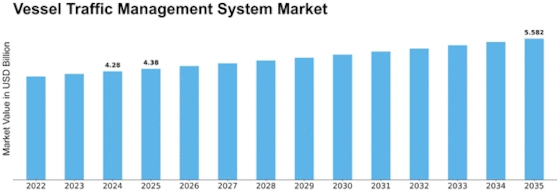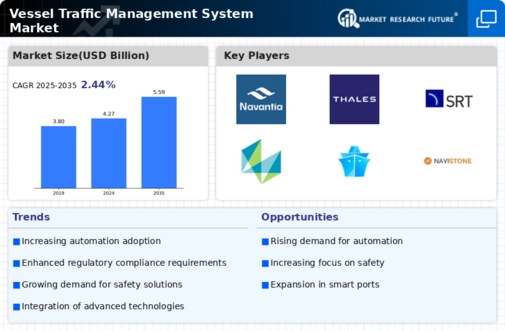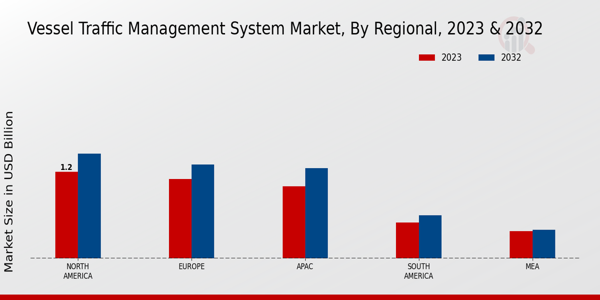-
EXECUTIVE SUMMARY
-
Market Overview
-
Key Findings
-
Market Segmentation
-
Competitive Landscape
-
Challenges and Opportunities
-
Future Outlook
-
MARKET INTRODUCTION
-
Definition
-
Scope of the study
- Research Objective
- Assumption
- Limitations
-
RESEARCH METHODOLOGY
-
Overview
-
Data Mining
-
Secondary Research
-
Primary Research
- Primary Interviews and Information Gathering Process
- Breakdown of Primary Respondents
-
Forecasting Model
-
Market Size Estimation
- Bottom-Up Approach
- Top-Down Approach
-
Data Triangulation
-
Validation
-
MARKET DYNAMICS
-
Overview
-
Drivers
-
Restraints
-
Opportunities
-
MARKET FACTOR ANALYSIS
-
Value chain Analysis
-
Porter''s Five Forces Analysis
- Bargaining Power of Suppliers
- Bargaining Power of Buyers
- Threat of New Entrants
- Threat of Substitutes
- Intensity of Rivalry
-
COVID-19 Impact Analysis
- Market Impact Analysis
- Regional Impact
- Opportunity and Threat Analysis
-
VESSEL TRAFFIC MANAGEMENT SYSTEM MARKET, BY APPLICATION (USD BILLION)
-
Port Management
-
Shipping Safety
-
Traffic Monitoring
-
Vessel Tracking
-
VESSEL TRAFFIC MANAGEMENT SYSTEM MARKET, BY SYSTEM TYPE (USD BILLION)
-
Standalone Systems
-
Integrated Systems
-
Networked Systems
-
VESSEL TRAFFIC MANAGEMENT SYSTEM MARKET, BY END USE (USD BILLION)
-
Commercial Shipping
-
Fishing Industry
-
Military Applications
-
Coastal Surveillance
-
VESSEL TRAFFIC MANAGEMENT SYSTEM MARKET, BY DEPLOYMENT (USD BILLION)
-
On-Premise
-
Cloud-Based
-
Hybrid
-
VESSEL TRAFFIC MANAGEMENT SYSTEM MARKET, BY REGIONAL (USD BILLION)
-
North America
- US
- Canada
-
Europe
- Germany
- UK
- France
- Russia
- Italy
- Spain
- Rest of Europe
-
APAC
- China
- India
- Japan
- South Korea
- Malaysia
- Thailand
- Indonesia
- Rest of APAC
-
South America
- Brazil
- Mexico
- Argentina
- Rest of South America
-
MEA
- GCC Countries
- South Africa
- Rest of MEA
-
COMPETITIVE LANDSCAPE
-
Overview
-
Competitive Analysis
-
Market share Analysis
-
Major Growth Strategy in the Vessel Traffic Management System Market
-
Competitive Benchmarking
-
Leading Players in Terms of Number of Developments in the Vessel Traffic Management System Market
-
Key developments and growth strategies
- New Product Launch/Service Deployment
- Merger & Acquisitions
- Joint Ventures
-
Major Players Financial Matrix
- Sales and Operating Income
- Major Players R&D Expenditure. 2023
-
COMPANY PROFILES
-
Transas
- Financial Overview
- Products Offered
- Key Developments
- SWOT Analysis
- Key Strategies
-
Saab AB
- Financial Overview
- Products Offered
- Key Developments
- SWOT Analysis
- Key Strategies
-
Wärtsilä Corporation
- Financial Overview
- Products Offered
- Key Developments
- SWOT Analysis
- Key Strategies
-
Navantia
- Financial Overview
- Products Offered
- Key Developments
- SWOT Analysis
- Key Strategies
-
Thales Group
- Financial Overview
- Products Offered
- Key Developments
- SWOT Analysis
- Key Strategies
-
Indra Sistemas
- Financial Overview
- Products Offered
- Key Developments
- SWOT Analysis
- Key Strategies
-
IBM Corporation
- Financial Overview
- Products Offered
- Key Developments
- SWOT Analysis
- Key Strategies
-
SRT Marine Systems
- Financial Overview
- Products Offered
- Key Developments
- SWOT Analysis
- Key Strategies
-
Hexagon AB
- Financial Overview
- Products Offered
- Key Developments
- SWOT Analysis
- Key Strategies
-
MarineTraffic
- Financial Overview
- Products Offered
- Key Developments
- SWOT Analysis
- Key Strategies
-
Raytheon Technologies
- Financial Overview
- Products Offered
- Key Developments
- SWOT Analysis
- Key Strategies
-
Navis
- Financial Overview
- Products Offered
- Key Developments
- SWOT Analysis
- Key Strategies
-
Fugro
- Financial Overview
- Products Offered
- Key Developments
- SWOT Analysis
- Key Strategies
-
CMap
- Financial Overview
- Products Offered
- Key Developments
- SWOT Analysis
- Key Strategies
-
Kongsberg Gruppen
- Financial Overview
- Products Offered
- Key Developments
- SWOT Analysis
- Key Strategies
-
APPENDIX
-
References
-
Related Reports
-
LIST OF TABLES
-
LIST OF ASSUMPTIONS
-
NORTH AMERICA VESSEL TRAFFIC MANAGEMENT SYSTEM MARKET SIZE ESTIMATES & FORECAST, BY APPLICATION, 2019-2032 (USD BILLIONS)
-
NORTH AMERICA VESSEL TRAFFIC MANAGEMENT SYSTEM MARKET SIZE ESTIMATES & FORECAST, BY SYSTEM TYPE, 2019-2032 (USD BILLIONS)
-
NORTH AMERICA VESSEL TRAFFIC MANAGEMENT SYSTEM MARKET SIZE ESTIMATES & FORECAST, BY END USE, 2019-2032 (USD BILLIONS)
-
NORTH AMERICA VESSEL TRAFFIC MANAGEMENT SYSTEM MARKET SIZE ESTIMATES & FORECAST, BY DEPLOYMENT, 2019-2032 (USD BILLIONS)
-
NORTH AMERICA VESSEL TRAFFIC MANAGEMENT SYSTEM MARKET SIZE ESTIMATES & FORECAST, BY REGIONAL, 2019-2032 (USD BILLIONS)
-
US VESSEL TRAFFIC MANAGEMENT SYSTEM MARKET SIZE ESTIMATES & FORECAST, BY APPLICATION, 2019-2032 (USD BILLIONS)
-
US VESSEL TRAFFIC MANAGEMENT SYSTEM MARKET SIZE ESTIMATES & FORECAST, BY SYSTEM TYPE, 2019-2032 (USD BILLIONS)
-
US VESSEL TRAFFIC MANAGEMENT SYSTEM MARKET SIZE ESTIMATES & FORECAST, BY END USE, 2019-2032 (USD BILLIONS)
-
US VESSEL TRAFFIC MANAGEMENT SYSTEM MARKET SIZE ESTIMATES & FORECAST, BY DEPLOYMENT, 2019-2032 (USD BILLIONS)
-
US VESSEL TRAFFIC MANAGEMENT SYSTEM MARKET SIZE ESTIMATES & FORECAST, BY REGIONAL, 2019-2032 (USD BILLIONS)
-
CANADA VESSEL TRAFFIC MANAGEMENT SYSTEM MARKET SIZE ESTIMATES & FORECAST, BY APPLICATION, 2019-2032 (USD BILLIONS)
-
CANADA VESSEL TRAFFIC MANAGEMENT SYSTEM MARKET SIZE ESTIMATES & FORECAST, BY SYSTEM TYPE, 2019-2032 (USD BILLIONS)
-
CANADA VESSEL TRAFFIC MANAGEMENT SYSTEM MARKET SIZE ESTIMATES & FORECAST, BY END USE, 2019-2032 (USD BILLIONS)
-
CANADA VESSEL TRAFFIC MANAGEMENT SYSTEM MARKET SIZE ESTIMATES & FORECAST, BY DEPLOYMENT, 2019-2032 (USD BILLIONS)
-
CANADA VESSEL TRAFFIC MANAGEMENT SYSTEM MARKET SIZE ESTIMATES & FORECAST, BY REGIONAL, 2019-2032 (USD BILLIONS)
-
EUROPE VESSEL TRAFFIC MANAGEMENT SYSTEM MARKET SIZE ESTIMATES & FORECAST, BY APPLICATION, 2019-2032 (USD BILLIONS)
-
EUROPE VESSEL TRAFFIC MANAGEMENT SYSTEM MARKET SIZE ESTIMATES & FORECAST, BY SYSTEM TYPE, 2019-2032 (USD BILLIONS)
-
EUROPE VESSEL TRAFFIC MANAGEMENT SYSTEM MARKET SIZE ESTIMATES & FORECAST, BY END USE, 2019-2032 (USD BILLIONS)
-
EUROPE VESSEL TRAFFIC MANAGEMENT SYSTEM MARKET SIZE ESTIMATES & FORECAST, BY DEPLOYMENT, 2019-2032 (USD BILLIONS)
-
EUROPE VESSEL TRAFFIC MANAGEMENT SYSTEM MARKET SIZE ESTIMATES & FORECAST, BY REGIONAL, 2019-2032 (USD BILLIONS)
-
GERMANY VESSEL TRAFFIC MANAGEMENT SYSTEM MARKET SIZE ESTIMATES & FORECAST, BY APPLICATION, 2019-2032 (USD BILLIONS)
-
GERMANY VESSEL TRAFFIC MANAGEMENT SYSTEM MARKET SIZE ESTIMATES & FORECAST, BY SYSTEM TYPE, 2019-2032 (USD BILLIONS)
-
GERMANY VESSEL TRAFFIC MANAGEMENT SYSTEM MARKET SIZE ESTIMATES & FORECAST, BY END USE, 2019-2032 (USD BILLIONS)
-
GERMANY VESSEL TRAFFIC MANAGEMENT SYSTEM MARKET SIZE ESTIMATES & FORECAST, BY DEPLOYMENT, 2019-2032 (USD BILLIONS)
-
GERMANY VESSEL TRAFFIC MANAGEMENT SYSTEM MARKET SIZE ESTIMATES & FORECAST, BY REGIONAL, 2019-2032 (USD BILLIONS)
-
UK VESSEL TRAFFIC MANAGEMENT SYSTEM MARKET SIZE ESTIMATES & FORECAST, BY APPLICATION, 2019-2032 (USD BILLIONS)
-
UK VESSEL TRAFFIC MANAGEMENT SYSTEM MARKET SIZE ESTIMATES & FORECAST, BY SYSTEM TYPE, 2019-2032 (USD BILLIONS)
-
UK VESSEL TRAFFIC MANAGEMENT SYSTEM MARKET SIZE ESTIMATES & FORECAST, BY END USE, 2019-2032 (USD BILLIONS)
-
UK VESSEL TRAFFIC MANAGEMENT SYSTEM MARKET SIZE ESTIMATES & FORECAST, BY DEPLOYMENT, 2019-2032 (USD BILLIONS)
-
UK VESSEL TRAFFIC MANAGEMENT SYSTEM MARKET SIZE ESTIMATES & FORECAST, BY REGIONAL, 2019-2032 (USD BILLIONS)
-
FRANCE VESSEL TRAFFIC MANAGEMENT SYSTEM MARKET SIZE ESTIMATES & FORECAST, BY APPLICATION, 2019-2032 (USD BILLIONS)
-
FRANCE VESSEL TRAFFIC MANAGEMENT SYSTEM MARKET SIZE ESTIMATES & FORECAST, BY SYSTEM TYPE, 2019-2032 (USD BILLIONS)
-
FRANCE VESSEL TRAFFIC MANAGEMENT SYSTEM MARKET SIZE ESTIMATES & FORECAST, BY END USE, 2019-2032 (USD BILLIONS)
-
FRANCE VESSEL TRAFFIC MANAGEMENT SYSTEM MARKET SIZE ESTIMATES & FORECAST, BY DEPLOYMENT, 2019-2032 (USD BILLIONS)
-
FRANCE VESSEL TRAFFIC MANAGEMENT SYSTEM MARKET SIZE ESTIMATES & FORECAST, BY REGIONAL, 2019-2032 (USD BILLIONS)
-
RUSSIA VESSEL TRAFFIC MANAGEMENT SYSTEM MARKET SIZE ESTIMATES & FORECAST, BY APPLICATION, 2019-2032 (USD BILLIONS)
-
RUSSIA VESSEL TRAFFIC MANAGEMENT SYSTEM MARKET SIZE ESTIMATES & FORECAST, BY SYSTEM TYPE, 2019-2032 (USD BILLIONS)
-
RUSSIA VESSEL TRAFFIC MANAGEMENT SYSTEM MARKET SIZE ESTIMATES & FORECAST, BY END USE, 2019-2032 (USD BILLIONS)
-
RUSSIA VESSEL TRAFFIC MANAGEMENT SYSTEM MARKET SIZE ESTIMATES & FORECAST, BY DEPLOYMENT, 2019-2032 (USD BILLIONS)
-
RUSSIA VESSEL TRAFFIC MANAGEMENT SYSTEM MARKET SIZE ESTIMATES & FORECAST, BY REGIONAL, 2019-2032 (USD BILLIONS)
-
ITALY VESSEL TRAFFIC MANAGEMENT SYSTEM MARKET SIZE ESTIMATES & FORECAST, BY APPLICATION, 2019-2032 (USD BILLIONS)
-
ITALY VESSEL TRAFFIC MANAGEMENT SYSTEM MARKET SIZE ESTIMATES & FORECAST, BY SYSTEM TYPE, 2019-2032 (USD BILLIONS)
-
ITALY VESSEL TRAFFIC MANAGEMENT SYSTEM MARKET SIZE ESTIMATES & FORECAST, BY END USE, 2019-2032 (USD BILLIONS)
-
ITALY VESSEL TRAFFIC MANAGEMENT SYSTEM MARKET SIZE ESTIMATES & FORECAST, BY DEPLOYMENT, 2019-2032 (USD BILLIONS)
-
ITALY VESSEL TRAFFIC MANAGEMENT SYSTEM MARKET SIZE ESTIMATES & FORECAST, BY REGIONAL, 2019-2032 (USD BILLIONS)
-
SPAIN VESSEL TRAFFIC MANAGEMENT SYSTEM MARKET SIZE ESTIMATES & FORECAST, BY APPLICATION, 2019-2032 (USD BILLIONS)
-
SPAIN VESSEL TRAFFIC MANAGEMENT SYSTEM MARKET SIZE ESTIMATES & FORECAST, BY SYSTEM TYPE, 2019-2032 (USD BILLIONS)
-
SPAIN VESSEL TRAFFIC MANAGEMENT SYSTEM MARKET SIZE ESTIMATES & FORECAST, BY END USE, 2019-2032 (USD BILLIONS)
-
SPAIN VESSEL TRAFFIC MANAGEMENT SYSTEM MARKET SIZE ESTIMATES & FORECAST, BY DEPLOYMENT, 2019-2032 (USD BILLIONS)
-
SPAIN VESSEL TRAFFIC MANAGEMENT SYSTEM MARKET SIZE ESTIMATES & FORECAST, BY REGIONAL, 2019-2032 (USD BILLIONS)
-
REST OF EUROPE VESSEL TRAFFIC MANAGEMENT SYSTEM MARKET SIZE ESTIMATES & FORECAST, BY APPLICATION, 2019-2032 (USD BILLIONS)
-
REST OF EUROPE VESSEL TRAFFIC MANAGEMENT SYSTEM MARKET SIZE ESTIMATES & FORECAST, BY SYSTEM TYPE, 2019-2032 (USD BILLIONS)
-
REST OF EUROPE VESSEL TRAFFIC MANAGEMENT SYSTEM MARKET SIZE ESTIMATES & FORECAST, BY END USE, 2019-2032 (USD BILLIONS)
-
REST OF EUROPE VESSEL TRAFFIC MANAGEMENT SYSTEM MARKET SIZE ESTIMATES & FORECAST, BY DEPLOYMENT, 2019-2032 (USD BILLIONS)
-
REST OF EUROPE VESSEL TRAFFIC MANAGEMENT SYSTEM MARKET SIZE ESTIMATES & FORECAST, BY REGIONAL, 2019-2032 (USD BILLIONS)
-
APAC VESSEL TRAFFIC MANAGEMENT SYSTEM MARKET SIZE ESTIMATES & FORECAST, BY APPLICATION, 2019-2032 (USD BILLIONS)
-
APAC VESSEL TRAFFIC MANAGEMENT SYSTEM MARKET SIZE ESTIMATES & FORECAST, BY SYSTEM TYPE, 2019-2032 (USD BILLIONS)
-
APAC VESSEL TRAFFIC MANAGEMENT SYSTEM MARKET SIZE ESTIMATES & FORECAST, BY END USE, 2019-2032 (USD BILLIONS)
-
APAC VESSEL TRAFFIC MANAGEMENT SYSTEM MARKET SIZE ESTIMATES & FORECAST, BY DEPLOYMENT, 2019-2032 (USD BILLIONS)
-
APAC VESSEL TRAFFIC MANAGEMENT SYSTEM MARKET SIZE ESTIMATES & FORECAST, BY REGIONAL, 2019-2032 (USD BILLIONS)
-
CHINA VESSEL TRAFFIC MANAGEMENT SYSTEM MARKET SIZE ESTIMATES & FORECAST, BY APPLICATION, 2019-2032 (USD BILLIONS)
-
CHINA VESSEL TRAFFIC MANAGEMENT SYSTEM MARKET SIZE ESTIMATES & FORECAST, BY SYSTEM TYPE, 2019-2032 (USD BILLIONS)
-
CHINA VESSEL TRAFFIC MANAGEMENT SYSTEM MARKET SIZE ESTIMATES & FORECAST, BY END USE, 2019-2032 (USD BILLIONS)
-
CHINA VESSEL TRAFFIC MANAGEMENT SYSTEM MARKET SIZE ESTIMATES & FORECAST, BY DEPLOYMENT, 2019-2032 (USD BILLIONS)
-
CHINA VESSEL TRAFFIC MANAGEMENT SYSTEM MARKET SIZE ESTIMATES & FORECAST, BY REGIONAL, 2019-2032 (USD BILLIONS)
-
INDIA VESSEL TRAFFIC MANAGEMENT SYSTEM MARKET SIZE ESTIMATES & FORECAST, BY APPLICATION, 2019-2032 (USD BILLIONS)
-
INDIA VESSEL TRAFFIC MANAGEMENT SYSTEM MARKET SIZE ESTIMATES & FORECAST, BY SYSTEM TYPE, 2019-2032 (USD BILLIONS)
-
INDIA VESSEL TRAFFIC MANAGEMENT SYSTEM MARKET SIZE ESTIMATES & FORECAST, BY END USE, 2019-2032 (USD BILLIONS)
-
INDIA VESSEL TRAFFIC MANAGEMENT SYSTEM MARKET SIZE ESTIMATES & FORECAST, BY DEPLOYMENT, 2019-2032 (USD BILLIONS)
-
INDIA VESSEL TRAFFIC MANAGEMENT SYSTEM MARKET SIZE ESTIMATES & FORECAST, BY REGIONAL, 2019-2032 (USD BILLIONS)
-
JAPAN VESSEL TRAFFIC MANAGEMENT SYSTEM MARKET SIZE ESTIMATES & FORECAST, BY APPLICATION, 2019-2032 (USD BILLIONS)
-
JAPAN VESSEL TRAFFIC MANAGEMENT SYSTEM MARKET SIZE ESTIMATES & FORECAST, BY SYSTEM TYPE, 2019-2032 (USD BILLIONS)
-
JAPAN VESSEL TRAFFIC MANAGEMENT SYSTEM MARKET SIZE ESTIMATES & FORECAST, BY END USE, 2019-2032 (USD BILLIONS)
-
JAPAN VESSEL TRAFFIC MANAGEMENT SYSTEM MARKET SIZE ESTIMATES & FORECAST, BY DEPLOYMENT, 2019-2032 (USD BILLIONS)
-
JAPAN VESSEL TRAFFIC MANAGEMENT SYSTEM MARKET SIZE ESTIMATES & FORECAST, BY REGIONAL, 2019-2032 (USD BILLIONS)
-
SOUTH KOREA VESSEL TRAFFIC MANAGEMENT SYSTEM MARKET SIZE ESTIMATES & FORECAST, BY APPLICATION, 2019-2032 (USD BILLIONS)
-
SOUTH KOREA VESSEL TRAFFIC MANAGEMENT SYSTEM MARKET SIZE ESTIMATES & FORECAST, BY SYSTEM TYPE, 2019-2032 (USD BILLIONS)
-
SOUTH KOREA VESSEL TRAFFIC MANAGEMENT SYSTEM MARKET SIZE ESTIMATES & FORECAST, BY END USE, 2019-2032 (USD BILLIONS)
-
SOUTH KOREA VESSEL TRAFFIC MANAGEMENT SYSTEM MARKET SIZE ESTIMATES & FORECAST, BY DEPLOYMENT, 2019-2032 (USD BILLIONS)
-
SOUTH KOREA VESSEL TRAFFIC MANAGEMENT SYSTEM MARKET SIZE ESTIMATES & FORECAST, BY REGIONAL, 2019-2032 (USD BILLIONS)
-
MALAYSIA VESSEL TRAFFIC MANAGEMENT SYSTEM MARKET SIZE ESTIMATES & FORECAST, BY APPLICATION, 2019-2032 (USD BILLIONS)
-
MALAYSIA VESSEL TRAFFIC MANAGEMENT SYSTEM MARKET SIZE ESTIMATES & FORECAST, BY SYSTEM TYPE, 2019-2032 (USD BILLIONS)
-
MALAYSIA VESSEL TRAFFIC MANAGEMENT SYSTEM MARKET SIZE ESTIMATES & FORECAST, BY END USE, 2019-2032 (USD BILLIONS)
-
MALAYSIA VESSEL TRAFFIC MANAGEMENT SYSTEM MARKET SIZE ESTIMATES & FORECAST, BY DEPLOYMENT, 2019-2032 (USD BILLIONS)
-
MALAYSIA VESSEL TRAFFIC MANAGEMENT SYSTEM MARKET SIZE ESTIMATES & FORECAST, BY REGIONAL, 2019-2032 (USD BILLIONS)
-
THAILAND VESSEL TRAFFIC MANAGEMENT SYSTEM MARKET SIZE ESTIMATES & FORECAST, BY APPLICATION, 2019-2032 (USD BILLIONS)
-
THAILAND VESSEL TRAFFIC MANAGEMENT SYSTEM MARKET SIZE ESTIMATES & FORECAST, BY SYSTEM TYPE, 2019-2032 (USD BILLIONS)
-
THAILAND VESSEL TRAFFIC MANAGEMENT SYSTEM MARKET SIZE ESTIMATES & FORECAST, BY END USE, 2019-2032 (USD BILLIONS)
-
THAILAND VESSEL TRAFFIC MANAGEMENT SYSTEM MARKET SIZE ESTIMATES & FORECAST, BY DEPLOYMENT, 2019-2032 (USD BILLIONS)
-
THAILAND VESSEL TRAFFIC MANAGEMENT SYSTEM MARKET SIZE ESTIMATES & FORECAST, BY REGIONAL, 2019-2032 (USD BILLIONS)
-
INDONESIA VESSEL TRAFFIC MANAGEMENT SYSTEM MARKET SIZE ESTIMATES & FORECAST, BY APPLICATION, 2019-2032 (USD BILLIONS)
-
INDONESIA VESSEL TRAFFIC MANAGEMENT SYSTEM MARKET SIZE ESTIMATES & FORECAST, BY SYSTEM TYPE, 2019-2032 (USD BILLIONS)
-
INDONESIA VESSEL TRAFFIC MANAGEMENT SYSTEM MARKET SIZE ESTIMATES & FORECAST, BY END USE, 2019-2032 (USD BILLIONS)
-
INDONESIA VESSEL TRAFFIC MANAGEMENT SYSTEM MARKET SIZE ESTIMATES & FORECAST, BY DEPLOYMENT, 2019-2032 (USD BILLIONS)
-
INDONESIA VESSEL TRAFFIC MANAGEMENT SYSTEM MARKET SIZE ESTIMATES & FORECAST, BY REGIONAL, 2019-2032 (USD BILLIONS)
-
REST OF APAC VESSEL TRAFFIC MANAGEMENT SYSTEM MARKET SIZE ESTIMATES & FORECAST, BY APPLICATION, 2019-2032 (USD BILLIONS)
-
REST OF APAC VESSEL TRAFFIC MANAGEMENT SYSTEM MARKET SIZE ESTIMATES & FORECAST, BY SYSTEM TYPE, 2019-2032 (USD BILLIONS)
-
REST OF APAC VESSEL TRAFFIC MANAGEMENT SYSTEM MARKET SIZE ESTIMATES & FORECAST, BY END USE, 2019-2032 (USD BILLIONS)
-
REST OF APAC VESSEL TRAFFIC MANAGEMENT SYSTEM MARKET SIZE ESTIMATES & FORECAST, BY DEPLOYMENT, 2019-2032 (USD BILLIONS)
-
REST OF APAC VESSEL TRAFFIC MANAGEMENT SYSTEM MARKET SIZE ESTIMATES & FORECAST, BY REGIONAL, 2019-2032 (USD BILLIONS)
-
SOUTH AMERICA VESSEL TRAFFIC MANAGEMENT SYSTEM MARKET SIZE ESTIMATES & FORECAST, BY APPLICATION, 2019-2032 (USD BILLIONS)
-
SOUTH AMERICA VESSEL TRAFFIC MANAGEMENT SYSTEM MARKET SIZE ESTIMATES & FORECAST, BY SYSTEM TYPE, 2019-2032 (USD BILLIONS)
-
SOUTH AMERICA VESSEL TRAFFIC MANAGEMENT SYSTEM MARKET SIZE ESTIMATES & FORECAST, BY END USE, 2019-2032 (USD BILLIONS)
-
SOUTH AMERICA VESSEL TRAFFIC MANAGEMENT SYSTEM MARKET SIZE ESTIMATES & FORECAST, BY DEPLOYMENT, 2019-2032 (USD BILLIONS)
-
SOUTH AMERICA VESSEL TRAFFIC MANAGEMENT SYSTEM MARKET SIZE ESTIMATES & FORECAST, BY REGIONAL, 2019-2032 (USD BILLIONS)
-
BRAZIL VESSEL TRAFFIC MANAGEMENT SYSTEM MARKET SIZE ESTIMATES & FORECAST, BY APPLICATION, 2019-2032 (USD BILLIONS)
-
BRAZIL VESSEL TRAFFIC MANAGEMENT SYSTEM MARKET SIZE ESTIMATES & FORECAST, BY SYSTEM TYPE, 2019-2032 (USD BILLIONS)
-
BRAZIL VESSEL TRAFFIC MANAGEMENT SYSTEM MARKET SIZE ESTIMATES & FORECAST, BY END USE, 2019-2032 (USD BILLIONS)
-
BRAZIL VESSEL TRAFFIC MANAGEMENT SYSTEM MARKET SIZE ESTIMATES & FORECAST, BY DEPLOYMENT, 2019-2032 (USD BILLIONS)
-
BRAZIL VESSEL TRAFFIC MANAGEMENT SYSTEM MARKET SIZE ESTIMATES & FORECAST, BY REGIONAL, 2019-2032 (USD BILLIONS)
-
MEXICO VESSEL TRAFFIC MANAGEMENT SYSTEM MARKET SIZE ESTIMATES & FORECAST, BY APPLICATION, 2019-2032 (USD BILLIONS)
-
MEXICO VESSEL TRAFFIC MANAGEMENT SYSTEM MARKET SIZE ESTIMATES & FORECAST, BY SYSTEM TYPE, 2019-2032 (USD BILLIONS)
-
MEXICO VESSEL TRAFFIC MANAGEMENT SYSTEM MARKET SIZE ESTIMATES & FORECAST, BY END USE, 2019-2032 (USD BILLIONS)
-
MEXICO VESSEL TRAFFIC MANAGEMENT SYSTEM MARKET SIZE ESTIMATES & FORECAST, BY DEPLOYMENT, 2019-2032 (USD BILLIONS)
-
MEXICO VESSEL TRAFFIC MANAGEMENT SYSTEM MARKET SIZE ESTIMATES & FORECAST, BY REGIONAL, 2019-2032 (USD BILLIONS)
-
ARGENTINA VESSEL TRAFFIC MANAGEMENT SYSTEM MARKET SIZE ESTIMATES & FORECAST, BY APPLICATION, 2019-2032 (USD BILLIONS)
-
ARGENTINA VESSEL TRAFFIC MANAGEMENT SYSTEM MARKET SIZE ESTIMATES & FORECAST, BY SYSTEM TYPE, 2019-2032 (USD BILLIONS)
-
ARGENTINA VESSEL TRAFFIC MANAGEMENT SYSTEM MARKET SIZE ESTIMATES & FORECAST, BY END USE, 2019-2032 (USD BILLIONS)
-
ARGENTINA VESSEL TRAFFIC MANAGEMENT SYSTEM MARKET SIZE ESTIMATES & FORECAST, BY DEPLOYMENT, 2019-2032 (USD BILLIONS)
-
ARGENTINA VESSEL TRAFFIC MANAGEMENT SYSTEM MARKET SIZE ESTIMATES & FORECAST, BY REGIONAL, 2019-2032 (USD BILLIONS)
-
REST OF SOUTH AMERICA VESSEL TRAFFIC MANAGEMENT SYSTEM MARKET SIZE ESTIMATES & FORECAST, BY APPLICATION, 2019-2032 (USD BILLIONS)
-
REST OF SOUTH AMERICA VESSEL TRAFFIC MANAGEMENT SYSTEM MARKET SIZE ESTIMATES & FORECAST, BY SYSTEM TYPE, 2019-2032 (USD BILLIONS)
-
REST OF SOUTH AMERICA VESSEL TRAFFIC MANAGEMENT SYSTEM MARKET SIZE ESTIMATES & FORECAST, BY END USE, 2019-2032 (USD BILLIONS)
-
REST OF SOUTH AMERICA VESSEL TRAFFIC MANAGEMENT SYSTEM MARKET SIZE ESTIMATES & FORECAST, BY DEPLOYMENT, 2019-2032 (USD BILLIONS)
-
REST OF SOUTH AMERICA VESSEL TRAFFIC MANAGEMENT SYSTEM MARKET SIZE ESTIMATES & FORECAST, BY REGIONAL, 2019-2032 (USD BILLIONS)
-
MEA VESSEL TRAFFIC MANAGEMENT SYSTEM MARKET SIZE ESTIMATES & FORECAST, BY APPLICATION, 2019-2032 (USD BILLIONS)
-
MEA VESSEL TRAFFIC MANAGEMENT SYSTEM MARKET SIZE ESTIMATES & FORECAST, BY SYSTEM TYPE, 2019-2032 (USD BILLIONS)
-
MEA VESSEL TRAFFIC MANAGEMENT SYSTEM MARKET SIZE ESTIMATES & FORECAST, BY END USE, 2019-2032 (USD BILLIONS)
-
MEA VESSEL TRAFFIC MANAGEMENT SYSTEM MARKET SIZE ESTIMATES & FORECAST, BY DEPLOYMENT, 2019-2032 (USD BILLIONS)
-
MEA VESSEL TRAFFIC MANAGEMENT SYSTEM MARKET SIZE ESTIMATES & FORECAST, BY REGIONAL, 2019-2032 (USD BILLIONS)
-
GCC COUNTRIES VESSEL TRAFFIC MANAGEMENT SYSTEM MARKET SIZE ESTIMATES & FORECAST, BY APPLICATION, 2019-2032 (USD BILLIONS)
-
GCC COUNTRIES VESSEL TRAFFIC MANAGEMENT SYSTEM MARKET SIZE ESTIMATES & FORECAST, BY SYSTEM TYPE, 2019-2032 (USD BILLIONS)
-
GCC COUNTRIES VESSEL TRAFFIC MANAGEMENT SYSTEM MARKET SIZE ESTIMATES & FORECAST, BY END USE, 2019-2032 (USD BILLIONS)
-
GCC COUNTRIES VESSEL TRAFFIC MANAGEMENT SYSTEM MARKET SIZE ESTIMATES & FORECAST, BY DEPLOYMENT, 2019-2032 (USD BILLIONS)
-
GCC COUNTRIES VESSEL TRAFFIC MANAGEMENT SYSTEM MARKET SIZE ESTIMATES & FORECAST, BY REGIONAL, 2019-2032 (USD BILLIONS)
-
SOUTH AFRICA VESSEL TRAFFIC MANAGEMENT SYSTEM MARKET SIZE ESTIMATES & FORECAST, BY APPLICATION, 2019-2032 (USD BILLIONS)
-
SOUTH AFRICA VESSEL TRAFFIC MANAGEMENT SYSTEM MARKET SIZE ESTIMATES & FORECAST, BY SYSTEM TYPE, 2019-2032 (USD BILLIONS)
-
SOUTH AFRICA VESSEL TRAFFIC MANAGEMENT SYSTEM MARKET SIZE ESTIMATES & FORECAST, BY END USE, 2019-2032 (USD BILLIONS)
-
SOUTH AFRICA VESSEL TRAFFIC MANAGEMENT SYSTEM MARKET SIZE ESTIMATES & FORECAST, BY DEPLOYMENT, 2019-2032 (USD BILLIONS)
-
SOUTH AFRICA VESSEL TRAFFIC MANAGEMENT SYSTEM MARKET SIZE ESTIMATES & FORECAST, BY REGIONAL, 2019-2032 (USD BILLIONS)
-
REST OF MEA VESSEL TRAFFIC MANAGEMENT SYSTEM MARKET SIZE ESTIMATES & FORECAST, BY APPLICATION, 2019-2032 (USD BILLIONS)
-
REST OF MEA VESSEL TRAFFIC MANAGEMENT SYSTEM MARKET SIZE ESTIMATES & FORECAST, BY SYSTEM TYPE, 2019-2032 (USD BILLIONS)
-
REST OF MEA VESSEL TRAFFIC MANAGEMENT SYSTEM MARKET SIZE ESTIMATES & FORECAST, BY END USE, 2019-2032 (USD BILLIONS)
-
REST OF MEA VESSEL TRAFFIC MANAGEMENT SYSTEM MARKET SIZE ESTIMATES & FORECAST, BY DEPLOYMENT, 2019-2032 (USD BILLIONS)
-
REST OF MEA VESSEL TRAFFIC MANAGEMENT SYSTEM MARKET SIZE ESTIMATES & FORECAST, BY REGIONAL, 2019-2032 (USD BILLIONS)
-
PRODUCT LAUNCH/PRODUCT DEVELOPMENT/APPROVAL
-
ACQUISITION/PARTNERSHIP
-
LIST OF FIGURES
-
MARKET SYNOPSIS
-
NORTH AMERICA VESSEL TRAFFIC MANAGEMENT SYSTEM MARKET ANALYSIS
-
US VESSEL TRAFFIC MANAGEMENT SYSTEM MARKET ANALYSIS BY APPLICATION
-
US VESSEL TRAFFIC MANAGEMENT SYSTEM MARKET ANALYSIS BY SYSTEM TYPE
-
US VESSEL TRAFFIC MANAGEMENT SYSTEM MARKET ANALYSIS BY END USE
-
US VESSEL TRAFFIC MANAGEMENT SYSTEM MARKET ANALYSIS BY DEPLOYMENT
-
US VESSEL TRAFFIC MANAGEMENT SYSTEM MARKET ANALYSIS BY REGIONAL
-
CANADA VESSEL TRAFFIC MANAGEMENT SYSTEM MARKET ANALYSIS BY APPLICATION
-
CANADA VESSEL TRAFFIC MANAGEMENT SYSTEM MARKET ANALYSIS BY SYSTEM TYPE
-
CANADA VESSEL TRAFFIC MANAGEMENT SYSTEM MARKET ANALYSIS BY END USE
-
CANADA VESSEL TRAFFIC MANAGEMENT SYSTEM MARKET ANALYSIS BY DEPLOYMENT
-
CANADA VESSEL TRAFFIC MANAGEMENT SYSTEM MARKET ANALYSIS BY REGIONAL
-
EUROPE VESSEL TRAFFIC MANAGEMENT SYSTEM MARKET ANALYSIS
-
GERMANY VESSEL TRAFFIC MANAGEMENT SYSTEM MARKET ANALYSIS BY APPLICATION
-
GERMANY VESSEL TRAFFIC MANAGEMENT SYSTEM MARKET ANALYSIS BY SYSTEM TYPE
-
GERMANY VESSEL TRAFFIC MANAGEMENT SYSTEM MARKET ANALYSIS BY END USE
-
GERMANY VESSEL TRAFFIC MANAGEMENT SYSTEM MARKET ANALYSIS BY DEPLOYMENT
-
GERMANY VESSEL TRAFFIC MANAGEMENT SYSTEM MARKET ANALYSIS BY REGIONAL
-
UK VESSEL TRAFFIC MANAGEMENT SYSTEM MARKET ANALYSIS BY APPLICATION
-
UK VESSEL TRAFFIC MANAGEMENT SYSTEM MARKET ANALYSIS BY SYSTEM TYPE
-
UK VESSEL TRAFFIC MANAGEMENT SYSTEM MARKET ANALYSIS BY END USE
-
UK VESSEL TRAFFIC MANAGEMENT SYSTEM MARKET ANALYSIS BY DEPLOYMENT
-
UK VESSEL TRAFFIC MANAGEMENT SYSTEM MARKET ANALYSIS BY REGIONAL
-
FRANCE VESSEL TRAFFIC MANAGEMENT SYSTEM MARKET ANALYSIS BY APPLICATION
-
FRANCE VESSEL TRAFFIC MANAGEMENT SYSTEM MARKET ANALYSIS BY SYSTEM TYPE
-
FRANCE VESSEL TRAFFIC MANAGEMENT SYSTEM MARKET ANALYSIS BY END USE
-
FRANCE VESSEL TRAFFIC MANAGEMENT SYSTEM MARKET ANALYSIS BY DEPLOYMENT
-
FRANCE VESSEL TRAFFIC MANAGEMENT SYSTEM MARKET ANALYSIS BY REGIONAL
-
RUSSIA VESSEL TRAFFIC MANAGEMENT SYSTEM MARKET ANALYSIS BY APPLICATION
-
RUSSIA VESSEL TRAFFIC MANAGEMENT SYSTEM MARKET ANALYSIS BY SYSTEM TYPE
-
RUSSIA VESSEL TRAFFIC MANAGEMENT SYSTEM MARKET ANALYSIS BY END USE
-
RUSSIA VESSEL TRAFFIC MANAGEMENT SYSTEM MARKET ANALYSIS BY DEPLOYMENT
-
RUSSIA VESSEL TRAFFIC MANAGEMENT SYSTEM MARKET ANALYSIS BY REGIONAL
-
ITALY VESSEL TRAFFIC MANAGEMENT SYSTEM MARKET ANALYSIS BY APPLICATION
-
ITALY VESSEL TRAFFIC MANAGEMENT SYSTEM MARKET ANALYSIS BY SYSTEM TYPE
-
ITALY VESSEL TRAFFIC MANAGEMENT SYSTEM MARKET ANALYSIS BY END USE
-
ITALY VESSEL TRAFFIC MANAGEMENT SYSTEM MARKET ANALYSIS BY DEPLOYMENT
-
ITALY VESSEL TRAFFIC MANAGEMENT SYSTEM MARKET ANALYSIS BY REGIONAL
-
SPAIN VESSEL TRAFFIC MANAGEMENT SYSTEM MARKET ANALYSIS BY APPLICATION
-
SPAIN VESSEL TRAFFIC MANAGEMENT SYSTEM MARKET ANALYSIS BY SYSTEM TYPE
-
SPAIN VESSEL TRAFFIC MANAGEMENT SYSTEM MARKET ANALYSIS BY END USE
-
SPAIN VESSEL TRAFFIC MANAGEMENT SYSTEM MARKET ANALYSIS BY DEPLOYMENT
-
SPAIN VESSEL TRAFFIC MANAGEMENT SYSTEM MARKET ANALYSIS BY REGIONAL
-
REST OF EUROPE VESSEL TRAFFIC MANAGEMENT SYSTEM MARKET ANALYSIS BY APPLICATION
-
REST OF EUROPE VESSEL TRAFFIC MANAGEMENT SYSTEM MARKET ANALYSIS BY SYSTEM TYPE
-
REST OF EUROPE VESSEL TRAFFIC MANAGEMENT SYSTEM MARKET ANALYSIS BY END USE
-
REST OF EUROPE VESSEL TRAFFIC MANAGEMENT SYSTEM MARKET ANALYSIS BY DEPLOYMENT
-
REST OF EUROPE VESSEL TRAFFIC MANAGEMENT SYSTEM MARKET ANALYSIS BY REGIONAL
-
APAC VESSEL TRAFFIC MANAGEMENT SYSTEM MARKET ANALYSIS
-
CHINA VESSEL TRAFFIC MANAGEMENT SYSTEM MARKET ANALYSIS BY APPLICATION
-
CHINA VESSEL TRAFFIC MANAGEMENT SYSTEM MARKET ANALYSIS BY SYSTEM TYPE
-
CHINA VESSEL TRAFFIC MANAGEMENT SYSTEM MARKET ANALYSIS BY END USE
-
CHINA VESSEL TRAFFIC MANAGEMENT SYSTEM MARKET ANALYSIS BY DEPLOYMENT
-
CHINA VESSEL TRAFFIC MANAGEMENT SYSTEM MARKET ANALYSIS BY REGIONAL
-
INDIA VESSEL TRAFFIC MANAGEMENT SYSTEM MARKET ANALYSIS BY APPLICATION
-
INDIA VESSEL TRAFFIC MANAGEMENT SYSTEM MARKET ANALYSIS BY SYSTEM TYPE
-
INDIA VESSEL TRAFFIC MANAGEMENT SYSTEM MARKET ANALYSIS BY END USE
-
INDIA VESSEL TRAFFIC MANAGEMENT SYSTEM MARKET ANALYSIS BY DEPLOYMENT
-
INDIA VESSEL TRAFFIC MANAGEMENT SYSTEM MARKET ANALYSIS BY REGIONAL
-
JAPAN VESSEL TRAFFIC MANAGEMENT SYSTEM MARKET ANALYSIS BY APPLICATION
-
JAPAN VESSEL TRAFFIC MANAGEMENT SYSTEM MARKET ANALYSIS BY SYSTEM TYPE
-
JAPAN VESSEL TRAFFIC MANAGEMENT SYSTEM MARKET ANALYSIS BY END USE
-
JAPAN VESSEL TRAFFIC MANAGEMENT SYSTEM MARKET ANALYSIS BY DEPLOYMENT
-
JAPAN VESSEL TRAFFIC MANAGEMENT SYSTEM MARKET ANALYSIS BY REGIONAL
-
SOUTH KOREA VESSEL TRAFFIC MANAGEMENT SYSTEM MARKET ANALYSIS BY APPLICATION
-
SOUTH KOREA VESSEL TRAFFIC MANAGEMENT SYSTEM MARKET ANALYSIS BY SYSTEM TYPE
-
SOUTH KOREA VESSEL TRAFFIC MANAGEMENT SYSTEM MARKET ANALYSIS BY END USE
-
SOUTH KOREA VESSEL TRAFFIC MANAGEMENT SYSTEM MARKET ANALYSIS BY DEPLOYMENT
-
SOUTH KOREA VESSEL TRAFFIC MANAGEMENT SYSTEM MARKET ANALYSIS BY REGIONAL
-
MALAYSIA VESSEL TRAFFIC MANAGEMENT SYSTEM MARKET ANALYSIS BY APPLICATION
-
MALAYSIA VESSEL TRAFFIC MANAGEMENT SYSTEM MARKET ANALYSIS BY SYSTEM TYPE
-
MALAYSIA VESSEL TRAFFIC MANAGEMENT SYSTEM MARKET ANALYSIS BY END USE
-
MALAYSIA VESSEL TRAFFIC MANAGEMENT SYSTEM MARKET ANALYSIS BY DEPLOYMENT
-
MALAYSIA VESSEL TRAFFIC MANAGEMENT SYSTEM MARKET ANALYSIS BY REGIONAL
-
THAILAND VESSEL TRAFFIC MANAGEMENT SYSTEM MARKET ANALYSIS BY APPLICATION
-
THAILAND VESSEL TRAFFIC MANAGEMENT SYSTEM MARKET ANALYSIS BY SYSTEM TYPE
-
THAILAND VESSEL TRAFFIC MANAGEMENT SYSTEM MARKET ANALYSIS BY END USE
-
THAILAND VESSEL TRAFFIC MANAGEMENT SYSTEM MARKET ANALYSIS BY DEPLOYMENT
-
THAILAND VESSEL TRAFFIC MANAGEMENT SYSTEM MARKET ANALYSIS BY REGIONAL
-
INDONESIA VESSEL TRAFFIC MANAGEMENT SYSTEM MARKET ANALYSIS BY APPLICATION
-
INDONESIA VESSEL TRAFFIC MANAGEMENT SYSTEM MARKET ANALYSIS BY SYSTEM TYPE
-
INDONESIA VESSEL TRAFFIC MANAGEMENT SYSTEM MARKET ANALYSIS BY END USE
-
INDONESIA VESSEL TRAFFIC MANAGEMENT SYSTEM MARKET ANALYSIS BY DEPLOYMENT
-
INDONESIA VESSEL TRAFFIC MANAGEMENT SYSTEM MARKET ANALYSIS BY REGIONAL
-
REST OF APAC VESSEL TRAFFIC MANAGEMENT SYSTEM MARKET ANALYSIS BY APPLICATION
-
REST OF APAC VESSEL TRAFFIC MANAGEMENT SYSTEM MARKET ANALYSIS BY SYSTEM TYPE
-
REST OF APAC VESSEL TRAFFIC MANAGEMENT SYSTEM MARKET ANALYSIS BY END USE
-
REST OF APAC VESSEL TRAFFIC MANAGEMENT SYSTEM MARKET ANALYSIS BY DEPLOYMENT
-
REST OF APAC VESSEL TRAFFIC MANAGEMENT SYSTEM MARKET ANALYSIS BY REGIONAL
-
SOUTH AMERICA VESSEL TRAFFIC MANAGEMENT SYSTEM MARKET ANALYSIS
-
BRAZIL VESSEL TRAFFIC MANAGEMENT SYSTEM MARKET ANALYSIS BY APPLICATION
-
BRAZIL VESSEL TRAFFIC MANAGEMENT SYSTEM MARKET ANALYSIS BY SYSTEM TYPE
-
BRAZIL VESSEL TRAFFIC MANAGEMENT SYSTEM MARKET ANALYSIS BY END USE
-
BRAZIL VESSEL TRAFFIC MANAGEMENT SYSTEM MARKET ANALYSIS BY DEPLOYMENT
-
BRAZIL VESSEL TRAFFIC MANAGEMENT SYSTEM MARKET ANALYSIS BY REGIONAL
-
MEXICO VESSEL TRAFFIC MANAGEMENT SYSTEM MARKET ANALYSIS BY APPLICATION
-
MEXICO VESSEL TRAFFIC MANAGEMENT SYSTEM MARKET ANALYSIS BY SYSTEM TYPE
-
MEXICO VESSEL TRAFFIC MANAGEMENT SYSTEM MARKET ANALYSIS BY END USE
-
MEXICO VESSEL TRAFFIC MANAGEMENT SYSTEM MARKET ANALYSIS BY DEPLOYMENT
-
MEXICO VESSEL TRAFFIC MANAGEMENT SYSTEM MARKET ANALYSIS BY REGIONAL
-
ARGENTINA VESSEL TRAFFIC MANAGEMENT SYSTEM MARKET ANALYSIS BY APPLICATION
-
ARGENTINA VESSEL TRAFFIC MANAGEMENT SYSTEM MARKET ANALYSIS BY SYSTEM TYPE
-
ARGENTINA VESSEL TRAFFIC MANAGEMENT SYSTEM MARKET ANALYSIS BY END USE
-
ARGENTINA VESSEL TRAFFIC MANAGEMENT SYSTEM MARKET ANALYSIS BY DEPLOYMENT
-
ARGENTINA VESSEL TRAFFIC MANAGEMENT SYSTEM MARKET ANALYSIS BY REGIONAL
-
REST OF SOUTH AMERICA VESSEL TRAFFIC MANAGEMENT SYSTEM MARKET ANALYSIS BY APPLICATION
-
REST OF SOUTH AMERICA VESSEL TRAFFIC MANAGEMENT SYSTEM MARKET ANALYSIS BY SYSTEM TYPE
-
REST OF SOUTH AMERICA VESSEL TRAFFIC MANAGEMENT SYSTEM MARKET ANALYSIS BY END USE
-
REST OF SOUTH AMERICA VESSEL TRAFFIC MANAGEMENT SYSTEM MARKET ANALYSIS BY DEPLOYMENT
-
REST OF SOUTH AMERICA VESSEL TRAFFIC MANAGEMENT SYSTEM MARKET ANALYSIS BY REGIONAL
-
MEA VESSEL TRAFFIC MANAGEMENT SYSTEM MARKET ANALYSIS
-
GCC COUNTRIES VESSEL TRAFFIC MANAGEMENT SYSTEM MARKET ANALYSIS BY APPLICATION
-
GCC COUNTRIES VESSEL TRAFFIC MANAGEMENT SYSTEM MARKET ANALYSIS BY SYSTEM TYPE
-
GCC COUNTRIES VESSEL TRAFFIC MANAGEMENT SYSTEM MARKET ANALYSIS BY END USE
-
GCC COUNTRIES VESSEL TRAFFIC MANAGEMENT SYSTEM MARKET ANALYSIS BY DEPLOYMENT
-
GCC COUNTRIES VESSEL TRAFFIC MANAGEMENT SYSTEM MARKET ANALYSIS BY REGIONAL
-
SOUTH AFRICA VESSEL TRAFFIC MANAGEMENT SYSTEM MARKET ANALYSIS BY APPLICATION
-
SOUTH AFRICA VESSEL TRAFFIC MANAGEMENT SYSTEM MARKET ANALYSIS BY SYSTEM TYPE
-
SOUTH AFRICA VESSEL TRAFFIC MANAGEMENT SYSTEM MARKET ANALYSIS BY END USE
-
SOUTH AFRICA VESSEL TRAFFIC MANAGEMENT SYSTEM MARKET ANALYSIS BY DEPLOYMENT
-
SOUTH AFRICA VESSEL TRAFFIC MANAGEMENT SYSTEM MARKET ANALYSIS BY REGIONAL
-
REST OF MEA VESSEL TRAFFIC MANAGEMENT SYSTEM MARKET ANALYSIS BY APPLICATION
-
REST OF MEA VESSEL TRAFFIC MANAGEMENT SYSTEM MARKET ANALYSIS BY SYSTEM TYPE
-
REST OF MEA VESSEL TRAFFIC MANAGEMENT SYSTEM MARKET ANALYSIS BY END USE
-
REST OF MEA VESSEL TRAFFIC MANAGEMENT SYSTEM MARKET ANALYSIS BY DEPLOYMENT
-
REST OF MEA VESSEL TRAFFIC MANAGEMENT SYSTEM MARKET ANALYSIS BY REGIONAL
-
KEY BUYING CRITERIA OF VESSEL TRAFFIC MANAGEMENT SYSTEM MARKET
-
RESEARCH PROCESS OF MRFR
-
DRO ANALYSIS OF VESSEL TRAFFIC MANAGEMENT SYSTEM MARKET
-
DRIVERS IMPACT ANALYSIS: VESSEL TRAFFIC MANAGEMENT SYSTEM MARKET
-
RESTRAINTS IMPACT ANALYSIS: VESSEL TRAFFIC MANAGEMENT SYSTEM MARKET
-
SUPPLY / VALUE CHAIN: VESSEL TRAFFIC MANAGEMENT SYSTEM MARKET
-
VESSEL TRAFFIC MANAGEMENT SYSTEM MARKET, BY APPLICATION, 2024 (% SHARE)
-
VESSEL TRAFFIC MANAGEMENT SYSTEM MARKET, BY APPLICATION, 2019 TO 2032 (USD Billions)
-
VESSEL TRAFFIC MANAGEMENT SYSTEM MARKET, BY SYSTEM TYPE, 2024 (% SHARE)
-
VESSEL TRAFFIC MANAGEMENT SYSTEM MARKET, BY SYSTEM TYPE, 2019 TO 2032 (USD Billions)
-
VESSEL TRAFFIC MANAGEMENT SYSTEM MARKET, BY END USE, 2024 (% SHARE)
-
VESSEL TRAFFIC MANAGEMENT SYSTEM MARKET, BY END USE, 2019 TO 2032 (USD Billions)
-
VESSEL TRAFFIC MANAGEMENT SYSTEM MARKET, BY DEPLOYMENT, 2024 (% SHARE)
-
VESSEL TRAFFIC MANAGEMENT SYSTEM MARKET, BY DEPLOYMENT, 2019 TO 2032 (USD Billions)
-
VESSEL TRAFFIC MANAGEMENT SYSTEM MARKET, BY REGIONAL, 2024 (% SHARE)
-
VESSEL TRAFFIC MANAGEMENT SYSTEM MARKET, BY REGIONAL, 2019 TO 2032 (USD Billions)
-
BENCHMARKING OF MAJOR COMPETITORS'










Leave a Comment